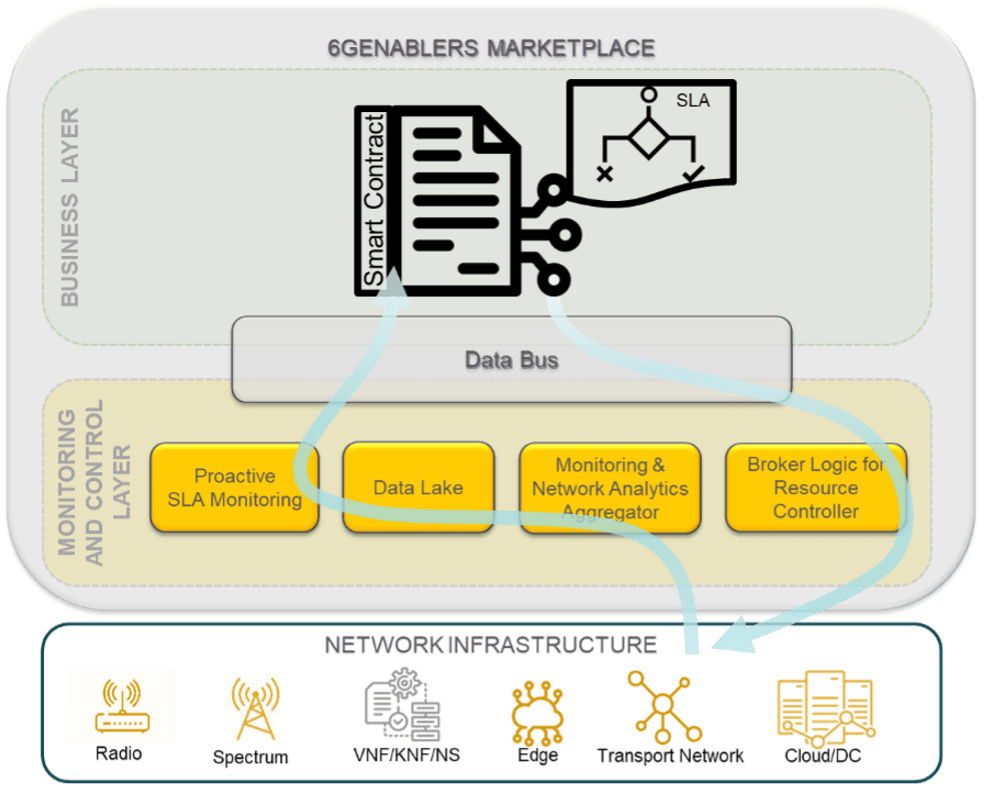
Keep up to date with our innovative initiatives.
Sign up here
In the 6GENABLERS Marketplace, Service Level Agreement (SLA) Assurance is a fundamental service that plays a crucial role in ensuring the reliable and auditable operation of the platform. It provides a monitoring tool that detects and forecasts any infraction or restoration of the defined metrics, when compared with the target values, to be notified to the Marketplace systems. Thus, it provides awareness of SLA violations and other components that can trigger an actuation.
Transparency on awareness of alarms enables healing reactions from the two involved actors. On the one hand, the offer provider could fix the issue on the provided items to restore the SLA. On the other hand, the order holder could stop the order and request a new order from another available offer. Going a step further, prevention is also viable, supported by AI/ML algorithms forecasting metrics. Accordingly, based on the Marketplace generated alerts, the offer provider could actuate to automatically prevent a likely situation in time.
The SLA Assurance is distributed in each Marketplace node. It is responsible for local monitoring and enforcing the SLA established between parties in the Marketplace. As a first step, this system takes care of launching the local deployment of the acquired resources and services. From this point onwards, it performs the tracking of Quality of Service (QoS) measurements relevant to the services and resources being provided, ensuring they meet the agreed-upon standards. These metrics are used to determine the fulfilment of SLAs and provide consumers and providers with insights into the quality of services. In cases where SLAs are not met, SLA Assurance ensures this incident is correctly stored in the ledger, making it available for consultation and further analytics in the case of disputes. Based on continuous monitoring and real-time analysis, SLA Assurance can also foresee potential order degradations and proactively alert on upcoming alarms before they are identified.
The main innovation of this component is translating Smart Contracts to different Network as a Service (NaaS) APIs and Orchestration backends and detecting and predicting unsatisfied SLAs. Thus, the core objectives are applying Smart Contracts to network infrastructures and generating information to foster the avoidance of unfavourable and penalty situations.

The internal architecture of the SLA Assurance system comprises five main functional entities. On top of a Data Bus delivering synchronous messages through Kafka, the implementation enables multiple systems to share states, relevant context information and any actuation at once. Then, the Broker Logic for the Resource Controller translates the orders to the local orchestrators and NaaS APIs to allocate and configure requested items from the underlying infrastructure. The Monitoring and Network Analytics Aggregator and the Data Lake retrieve the metrics identified in the Smart Contract from the monitoring system. Finally, Proactive SLA Monitoring turns the conditions declared in the Smart Contracts into evaluable equations from live captured metrics. When the condition is violated, an alarm is published to the Data Bus, where Marketplace clients and management systems can identify the issue transparently and react as preferred. Furthermore, this module can forecast violations based on predicted metrics. In this case, published alerts would enable resource managers to actuate before the alarm comes into play.
For sure, the information shared by those systems in the Data Bus would enable other ZeroTouch Systems to build a reputation profile and to train on demands and actuation to improve self-organizing network systems.
Author: Angel Martin, Senior Researcher at Vicomtech